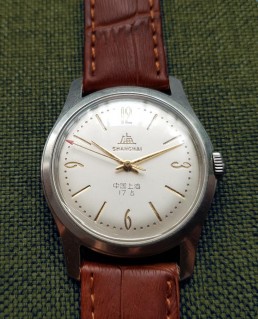From the mid-1950s through the ’70s, communist China’s state-run factories churned out cheap, mechanical wristwatches in the hundreds of millions, so every good comrade could own a timepiece. The most rare models are now collectors’ items.
WITH CHINESE CONTEMPORARY art commanding record prices in galleries from Beijing to Brooklyn, and the propaganda posters of the Mao Zedong era being faked in numbers, could simple, mechanical wristwatches — produced by the communist nation’s state-run factories from the 1950s to ’70s — be the next Chinese collectable to grab the spotlight?
Hong Kong-born Joel Chan believes so. With a personal collection numbering more than 700 vintage Chinese timepieces, the 38-year-old is a pioneer in a barely explored field of collecting that, he says, has no price barrier to entry.
Launched in 1963 and the first timepiece produced by the Shanghai First Watch Factory with a calendar function, the Shanghai A623 is just one of the many watches highlighted on Chan’s China watch blog (micmicmor.blogspot.com).
A623s were not available to the general public but only provided to high-ranking government and military officials, and this simple piece of kit is now known in collecting circles as the “minister watch” — because the first piece off the production line was strapped to the wrist of Zhou Enlai, then China’s premier and Mao’s right-hand man.
Zhou wore his trusty timepiece until his death in 1976, and it is now on display at the National Museum of China beside Beijing’s Tiananmen Square. Chan snapped up his A623 on eBay for just Rmb800 (about US$130).
A COLLECTOR OF early Seiko watches when he relocated to Shanghai with his job as director for a retail-development company in 2000, Chan says a love of country spurred his original interest in old Chinese timepieces. It was a chance meeting with Japanese collector that brought out the latent patriot — Chan was upset to learn that overseas collectors were snapping up China’s horological history.
“I was jealous of them,” he says, and so he immediately set about studying the subject.
Chan discovered that on the heels of the communist takeover of China in 1949, the Shanghai First Watch Factory — the first homegrown watch manufacturer to mass-produce in the country — was founded in 1955. Asked to choose favourites in his collection, he plumps for rare, handmade 1956 Shanghai prototypes of the Heping (meaning “Peace”) and Dong Fang Hong (“Red East”) models based on a classic Swiss movement.
Of the original 100 or so pieces, only 12 passed the new manufacturer’s stringent quality standards (gaining or losing no more than 120 seconds a day). Chan picked up his from private collectors for just a few hundred dollars each.
Those early Shanghai watches provided the basis for the mass-produced A581, which was launched in July 1958 and adorned many Chinese wrists until its discontinuation in 1966.
To ensure the masses got to their work units on time, many millions of A581s were made, making them relatively easy to pick up in Shanghai curio stores for as little as Rmb50. Their wide availability, plus the fact that they were crafted with a variety of style and colour variations to dial and casing, means that some collectors focus their attentions solely on the A581.
“One day, when the Chinese become more interested in their history, our circle will become bigger and prices will rise”
Chinese-watch collector Joel Chan
Also on his blog, Chan generously shares locations of the dusty Shanghai outlets where he adds to his treasures, respectfully listing their proprietors simply by their surnames: Mr Rong, whose quaint and rarely troubled store is at 378 Changle Lu, in the former French Concession, has Chan’s phone number and might call if a multi-jewelled gem lands in his careful hands. Ditto Mr Xie, at 425 Fong Bin Zhong Lu.
And when not scouring curio and antique shops, Chan frequents websites such as watchuseek.com, its Chinese Mechanical Watches forum being a gentlemanly safe space where he and a small clique of fellow aficionados from across the globe politely praise each other’s recent discoveries, discussing dial typographies and rare case engravings, and comparing prices.
Though Chan was delighted to learn that a 1955 watch similar to his Heping had sold at auction for Rmb110,000 in 1996, he still believes a functioning and practical piece of revolutionary history is within financial reach of even the most frugal collector, largely thanks to the modern Chinese preference for a Rolex or a Tag Heuer or a Tissot.
By contrast, he would prefer a special edition of the minister watch that was released to commemorate the successful testing of China first nuclear device in 1964. Its engraved steel back depicts nuclear fission.
“One day, when the Chinese become more interested in their history, our circle will become bigger and prices will rise,” says Chan, who has a book is in the pipeline. “But I don’t think that will happen soon. Until then it will be easy to pick up Chinese watches cheaply. Even many rare models can still be found for Rmb500.” ◉
SHARE


